Abstract
The Solov’ev-Vinitsky method was used to perform an ab initio calculation of the triple-differential cross section for the double single-photon photoionization of helium for the case of equal emitted-electron energies. A Gaussian width γ describing angular electron-electron correlations at the total electron energy E taking values in range between 0.1 and 100 eV was obtained for this cross section. The results agree with available experimental data, but they raise a doubt as to whether the well-known Wannier law γ ∝ E 1/4 is applicable at experimentally accessible energies. The Gaussian width γ was investigated as a function of the total emitted-electron energy for targets that have a strongly asymmetric configuration of the initial state—specifically, a negative atomic-hydrogen ion H− and heliumin the 1s2s 1 S and 1s3s 1 S excited states. It was found that this function, γ(E), had a maximum at low energies. It was also shown that, at low energies, the dependence of the double-differential cross section on the angle between the emitted-electron momenta for the targets indicated above differed substantially from the Gaussian dependence, featuring maxima whose number was equal to the number of radial nodes in the initial state. This opens new possibilities for a qualitative analysis of the electron structure of targets.
Similar content being viewed by others
References
G. H. Wannier, Phys. Rev. 90, 817 (1953).
J. S. Briggs and V. Schmidt, J. Phys. B 33, R1 (2000).
V. V. Serov, V. L. Derbov, B. B. Joulakian, and S. I. Vinitsky, Phys. Rev. A 78, 063403 (2008).
V. V. Serov, V. L. Derbov, B. B. Joulakian, and S. I. Vinitsky, Phys. Rev. A 75, 012715 (2007).
E. A. Soloviev and S. I. Vinitsky, J. Phys. B 18, L557 (1985).
E. Y. Sidky and B. D. Esry, Phys. Rev. Lett. 85, 5086 (2000).
A. K. Kazansky, P. Selles, and L. Malegat, Phys. Rev. A 68, 052701 (2003).
A. S. Kheifets and I. Bray, Phys.Rev.A 73, 020708(R) (2006).
A. Huetz, P. Selles, D. Waymel, and J. Mazeau, J. Phys. B 24, 1917 (1991).
A. R. P. Rau, J. Phys. B 9, L283 (1976).
S. Otranto and C. R. Garibotti, Phys. Rev. A 71, 034703 (2005).
A. K. Kazansky and V. N. Ostrovsky, J. Phys. B 26, 2231 (1993).
A. S. Kheifets and I. Bray, Phys. Rev. A 62, 065402 (2000).
A. Huetz and J. Mazeau, Phys. Rev. Lett. 85, 530 (2000).
L. Malegat, P. Selles, P. Lablanquie, et al., J. Phys. B 30, 263 (1997).
M. Foster and J. Colgan, J. Phys. B 39, 5067 (2006).
L. Malegat, P. Selles, and A. Kazansky, Phys. Rev. A 60, 3667 (1999).
G. Dawber et al., J. Phys. B 28, L271 (1995).
R. Dörner et al., Phys. Rev. A 57, 1074 (1998).
C. Dawson et al., J. Phys. B 34, L525 (2001).
G. Turri et al., Phys. Rev. A 65, 034702 (2002).
C. Dal Cappello, Yu. V. Popov, G. Stefani, et al., J. Phys. B 27, 1549 (1994).
Author information
Authors and Affiliations
Corresponding author
Additional information
Original Russian Text © V.V. Serov, 2013, published in Yadernaya Fizika, 2013, Vol. 76, No. 2, pp. 176–183.
Rights and permissions
About this article
Cite this article
Serov, V.V. Ab initio calculation of double ionization of atoms. Phys. Atom. Nuclei 76, 147–154 (2013). https://doi.org/10.1134/S1063778813010122
Received:
Accepted:
Published:
Issue Date:
DOI: https://doi.org/10.1134/S1063778813010122




